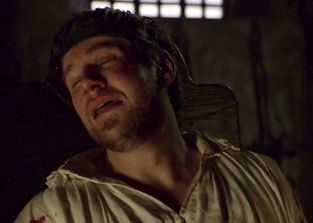Name Francis Dereham | ||
 | ||
Born 1513 (age 28) Died 10 December 1541 (aged 28), Tyburn, London | ||
Dublagem - The Tudors
Francis Dereham (c 1513 – executed (1541-12-10)10 December 1541) was a Tudor courtier whose involvement with Henry VIII's fifth Queen, Catherine Howard in her youth, was a principal cause of the Queen's execution.
Contents

Early life

Francis Dereham was the son of John (Thomas) Derham, of Crimplesham in Norfolk, and Isabell, the daughter of John Paynell, of Boothby in Lincolnshire.
Relationship with Catherine Howard

Dereham is known for his sexual indiscretions with Catherine Howard, the fifth wife of King Henry VIII of England, long before she became queen, when she was aged fifteen. Dereham convinced himself that he loved her when their affair began late in 1538. Dereham had previously been having an affair with Joan Bulmer who lived in the same household of Agnes Howard, Dowager Duchess of Norfolk in Norfolk House in Lambeth, but dropped her for Catherine Howard. Dereham's relationship with Catherine Howard came to an end when her music master, Henry Manox sent an anonymous letter to the Dowager Duchess. Manox, who had started a sexual relationship with the girl when she was only eleven, suggested to the Duchess that she should visit Catherine's bedroom "half an hour after" going to bed, adding that "you shall see that which shall displease you." As a consequence Dereham was sent away and Catherine was told off for her "banqueting by night" because she feared "it would hurt her beauty". David Starkey has argued that the Duchess was more concerned about Catherine's looks than her morals. Dereham was forced to go to live in Ireland where it is believed he resorted to piracy. Before he left he asked Catherine to look after £100. This money was the bulk of his savings and Catherine when Queen later admitted that he told her that if he did not return "I was to consider it as my own."

In late 1539 Catherine Howard was made lady-in-waiting to the King's fourth wife, Anne of Cleves. Subsequently, Dereham was appointed a secretary at Hampton Court, an appointment possibly engineered by the Dowager Duchess to silence him about Catherine's previous indiscretions. On 27 August 1541, using the Dowager Duchess as a reference, Dereham rashly approached his former lover at Pontefract Castle, seeking employment, while the court was still on progress. Queen Catherine made him her Private Secretary and then a Gentleman Usher of the Queen's Chamber. Dereham was a braggart, unable to keep his mouth shut. He brashly boasted that if the King died, he would marry Catherine, elaborating the situation by explaining he had been generously favoured by grants. The flagrant arrogance, possibly intended to arouse Culpepper's jealousy, caused some consternation at court. Dereham, the jilted lover, had a violent temper, getting drunk, he attacked John Fell, a Gentleman Usher of similar standing, who had questioned Dereham's pleasure at remaining seated after a Queen's Council meeting.
When their past relationship was brought to the attention of Archbishop Thomas Cranmer by a chamberer in the Dowager Duchess's household, Mary Lassells, he reported them to the King in a letter. This provoked an investigation which resulted in the arrests of the Dowager Duchess, her son William Howard, 1st Lord Howard of Effingham, Thomas Culpeper, Queen Catherine herself, and eventually Lady Rochford, one of Catherine's ladies-in-waiting. Under interrogation, Dereham admitted to a pre-marital relationship with Catherine, but claimed that they had never been intimate after Catherine's marriage to the King. Furthermore, he maintained that he had been supplanted in her affections by Culpeper.
Cranmer was faced with the rumours of a pre-contract of marriage between Dereham and Catherine. Such a pre-contract would effectively have been as binding as marriage itself, especially if the couple had sealed the agreement with sexual relations, and as a result Catherine's marriage to the King would have been unlawful. But no evidence exists to support this allegation; incriminating documents are thought to have been burned by the Dowager Duchess, as it is recorded that she raided Dereham's coffers and destroyed their letters. A supposed love letter from Catherine Howard was used as evidence of her adultery. Dereham admitted only that there had been a pre-contract of marriage. Catherine admitted having sexual relations on many occasions with Dereham but claimed that practised a method of birth control. When interrogated again Dereham denied any post-marital intercourse, but confessed that Culpeper "had succeeded him in the Queen's affections."
Execution
On the 4th of November 1541, Catherine Howard was taken to Syon, where she was imprisoned. On the 22nd of November it was announced that Catherine “had forfeited her honour and should be proceeded against by law, and was henceforth to be named no longer Queen, but only Catherine Howard.”
On the 1st of December 1541 Thomas Culpeper and Francis Dereham were arraigned at Guildhall for treason and sentenced to a traitor’s death. Both men petitioned Henry VIII to commute their death to beheading but only Culpeper was successful in his petition.
On the 10th December 1541. Dereham died a traitor's death at Tyburn, being hanged, drawn and quartered. Culpeper also died at Tyburn, but as he had been favoured by the King before his affair with Catherine, his sentence was commuted to beheading.
“Culpeper and Dereham were drawn from the Tower of London to Tyburn, and there Culpeper, after an exhortation made to the people to pray for him, he standing on the ground by the gallows, kneeled down and had his head stricken off; and then Dereham was hanged, membered, bowelled, headed, and quartered [and both] their heads set on London Bridge.”Catherine and Lady Rochford were beheaded at the Tower of London on 13 February 1542. The Dowager Duchess was eventually released.
